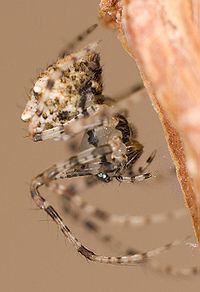Kingdom Animalia Suborder Araneomorphae Scientific name Ero Higher classification Pirate spider | Order Araneae Family Mimetidae Phylum Arthropoda Rank Genus | |
 | ||
Lower classifications Ero furcata, Ero cambridgei | ||
Ero is a genus of pirate spiders in the family Mimetidae.
Contents
Description
Members of this genus resemble the comb-footed spiders, Theridiidae, due to their globular abdomen which is higher than it is long. The upper side of this bears one or two pairs of conical tubercles and some curved bristle-like hairs. The anterior medial eyes project on small tubercles. Leg 1 is nearly twice as long as leg 4. The egg sacks are very characteristic being elongated globes about four millimetres in diameter, suspended on a silken thread from vegetation. They are made from an inner layer of yellowish brown silk and an outer layer of dark coloured, loosely woven silk which gives the sack a woolly appearance. The sacks are not guarded by the female and when the juveniles hatch, so they have to fend for themselves. Since Ero species are nocturnal, the adults are not often seen and the egg sacks often reveal their presence before specimens are found.
Feeding behaviour
Spiders in this genus are specialised spider killers. An individual will attack a potential victim by biting one of its legs and injecting toxins. It then retreats and the prey spider quickly becomes paralysed. The attacker then advances and starts to feed, sucking out the body fluids of its victim.
Species
The World Spider Catalog lists these species:
